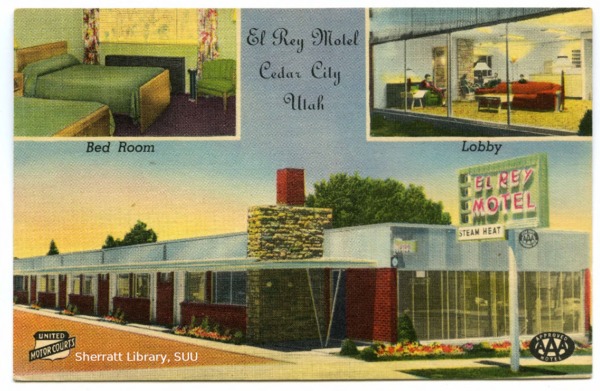Dublin Core
Title
Description
Paved roads and breathtaking scenery enticed thousands of tourists to southern Utah in the early twentieth century. Small towns along the newly built roads embraced visitors. As one local newspaper wrote, “tourists who stay, will keep the poverty away.” The Arrowhead Trail was built during the 1910s, and was the first all-weather road to connect Salt Lake City to Los Angeles. The route brought plenty of tourists to St. George, and local businessmen saw an opportunity to build comfortable lodgings to entice tired travelers to pull over and spend their money.
The last of the original Arrowhead Trail was oiled and graveled in 1931 and the number of tourists stopping in St. George grew steadily. Dozens of motels and motor courts popped up with large parking lots. Using neon signs, comfortable accommodations, and postcard advertisements, motels drew tourists off the highway. Rural charm was part of the appeal for tourists, and motel owners happily obliged. Swimming pools, ice makers, and friendly conversation could be expected at motels throughout southern Utah.
Advertisements helped bring more tourists to local motels by praising the scenic beauty of southern Utah. A 1936 issue of National Geographic featured a full-color spread of Zion, Bryce, and Cedar Breaks, among other national parks and monuments. The article described the vivid colors and breathtaking scenery of Utah’s rural lands, bolstering the “golden age” of road travel. After World War II, tourism skyrocketed and in 1956, visitors to Zion National Park numbered over 400,000 -- nearly doubling from just a decade earlier!
Like many other industries in Utah, local motels experienced their own boom-and-bust. At its peak, some 250 motels populated Utah’s roads, most of them located in rural areas. Eventually roads were improved and expanded to bypass small downtown communities. Today, the number of local hotels has dwindled to just around 100, with the great majority remaining in southern Utah. Although national parks continue to pull more tourists than ever, it is chain hotels and Airbnbs that now meet the demands of travelers. For many rural Utahns, tourism is a necessary industry, but one that has profoundly changed local business and natural resources.
Creator
Source
_______________
See Lisa Michele Church, “Early Roadside Motels and Motor Courts of St. George,” Utah Historical Quarterly (vol. 80, no. 1), Winter 2012; Andrew Wood, “The Rise and Fall of the Great American Motel,” Smithsonian Magazine, June 30, 2017; Carter Williams, “Mapping Utah’s Growth Through Historic Roadside Motels,” KSL News, May 17, 2018; Lindsey M. Evenson, Jennifer Bannick, and Everett Bassett, “Arrowhead Trail (AKA Old US-91 Highway),” condensed from Washington County Water Conservancy District’s Ash Creek Project - Historic Context for Four Historic Properties, Washington County, Utah, 2021.

